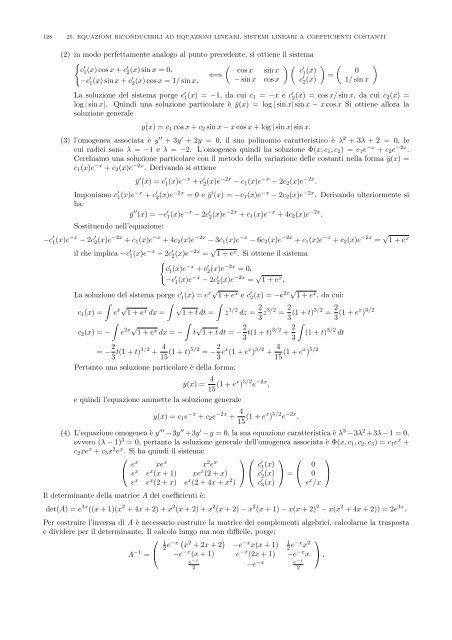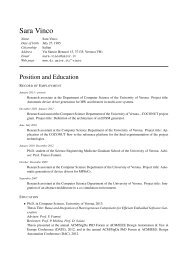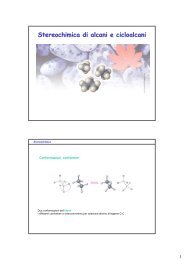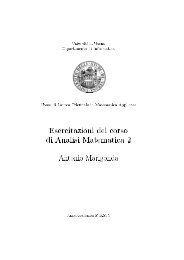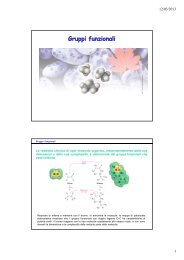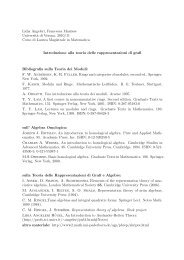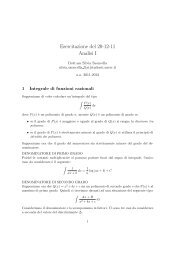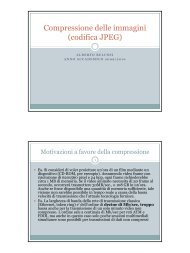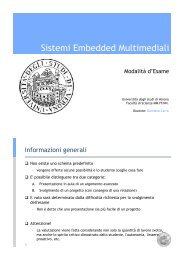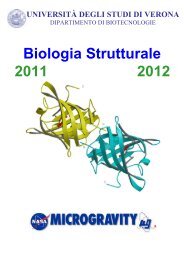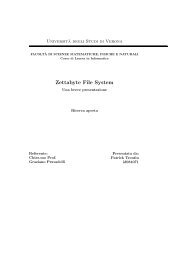Create successful ePaper yourself
Turn your PDF publications into a flip-book with our unique Google optimized e-Paper software.
128 25. EQUAZIONI RICONDUCIBILI AD EQUAZIONI LINEARI, SISTEMI LINEARI A COEFFICIENTI COSTANTI<br />
(2) in modo perfettamente analogo al punto precedente, si ottiene il sistema<br />
<br />
c ′ 1(x) cos x + c ′ 2(x) sin x = 0,<br />
−c ′ 1(x) sin x + c ′ 2(x) cos x = 1/ sin x, ⇐⇒<br />
cos x sin x<br />
− sin x cos x<br />
c ′ 1(x)<br />
c ′ 2(x)<br />
<br />
=<br />
0<br />
1/ sin x<br />
La soluzione del sistema porge c ′ 1(x) = −1, da cui c1 = −x e c ′ 2(x) = cos x/ sin x, da cui c2(x) =<br />
log | sin x|. Quindi una soluzione particolare è ¯y(x) = log | sin x| sin x − x cos x Si ottiene allora la<br />
soluzione generale<br />
y(x) = c1 cos x + c2 sin x − x cos x + log | sin x| sin x.<br />
(3) l’omogenea associata è y ′′ + 3y ′ + 2y = 0, il suo polinomio caratteristico è λ 2 + 3λ + 2 = 0, le<br />
cui radici sono λ = −1 e λ = −2. L’omogenea quindi ha soluzione Φ(x, c1, c2) = c1e −x + c2e −2x .<br />
Cerchiamo una soluzione particolare con il metodo della variazione delle costanti nella forma ¯y(x) =<br />
c1(x)e −x + c2(x)e −2x . Derivando si ottiene<br />
¯y ′ (x) = c ′ 1(x)e −x + c ′ 2(x)e −2x − c1(x)e −x − 2c2(x)e −2x .<br />
Imponiamo c ′ 1(x)e −x + c ′ 2(x)e −2x = 0 e ¯y ′ (x) = −c1(x)e −x − 2c2(x)e −2x . Derivando ulteriormente si<br />
ha:<br />
¯y ′′ (x) = −c ′ 1(x)e −x − 2c ′ 2(x)e −2x + c1(x)e −x + 4c2(x)e −2x .<br />
Sost<strong>it</strong>uendo nell’equazione:<br />
−c ′ 1(x)e −x − 2c ′ 2(x)e −2x + c1(x)e −x + 4c2(x)e −2x − 3c1(x)e −x − 6c2(x)e −2x + c1(x)e −x + c2(x)e −2x = √ 1 + e x<br />
il che implica −c ′ 1(x)e −x − 2c ′ 2(x)e −2x = √ 1 + e x . Si ottiene il sistema<br />
<br />
c ′ 1(x)e −x + c ′ 2(x)e −2x = 0,<br />
−c ′ 1(x)e −x − 2c ′ 2(x)e −2x = √ 1 + e x ,<br />
La soluzione del sistema porge c ′ 1(x) = e x√ 1 + e x e c ′ 2(x) = −e 2x√ 1 + e x , da cui:<br />
<br />
c1(x) = e x√ 1 + ex <br />
√1<br />
dx = + t dt = z 1/2 dz = 2<br />
3 z3/2 = 2<br />
3 (1 + t)3/2 = 2<br />
<br />
c2(x) = − e 2x√ 1 + ex <br />
dx = − t √ 1 + t dt = − 2<br />
3 t(1 + t)3/2 + 2<br />
<br />
(1 + t)<br />
3<br />
3/2 dt<br />
= − 2<br />
3 t(1 + t)3/2 + 4<br />
15 (1 + t)5/2 = − 2<br />
3 ex (1 + e x ) 3/2 + 4<br />
15 (1 + ex ) 5/2<br />
Pertanto una soluzione particolare è della forma:<br />
¯y(x) = 4<br />
15 (1 + ex ) 5/2 e −2x ,<br />
e quindi l’equazione ammette la soluzione generale<br />
y(x) = c1e −x + c2e −2x + 4<br />
15 (1 + ex ) 5/2 e −2x .<br />
3 (1 + ex ) 3/2<br />
(4) L’equazione omogenea è y ′′′ − 3y ′′ + 3y ′ − y = 0, la sua equazione caratteristica è λ 3 − 3λ 2 + 3λ − 1 = 0,<br />
ovvero (λ − 1) 3 = 0, pertanto la soluzione generale dell’omogenea associata è Φ(x, c1, c2, c3) = c1e x +<br />
c2xe x + c3x 2 e x . Si ha quindi il sistema:<br />
⎛<br />
⎝ ex xe x x 2 e x<br />
e x e x (x + 1) xe x (2 + x)<br />
e x e x (2 + x) e x (2 + 4x + x 2 )<br />
Il determinante della matrice A dei coefficienti è:<br />
⎞ ⎛<br />
⎠ ⎝ c′ 1(x)<br />
c ′ 2(x)<br />
c ′ 3(x)<br />
⎞<br />
⎠ =<br />
⎛<br />
⎝ 0<br />
0<br />
e x /x<br />
det(A) = e 3x ((x + 1)(x 2 + 4x + 2) + x 2 (x + 2) + x 2 (x + 2) − x 2 (x + 1) − x(x + 2) 2 − x(x 2 + 4x + 2)) = 2e 3x .<br />
Per costruire l’inversa di A è necessario costruire la matrice dei complementi algebrici, calcolarne la trasposta<br />
e dividere per il determinante. Il calcolo lungo ma non difficile, porge:<br />
A −1 ⎛ 1<br />
2<br />
= ⎝<br />
e−x x2 + 2x + 2 −e−x 1<br />
x(x + 1) 2e−xx2 −e−x (x + 1) e−x (2x + 1) −e−x ⎞<br />
x ⎠ .<br />
e −x<br />
−x e−x<br />
2 −e 2<br />
⎞<br />
⎠


